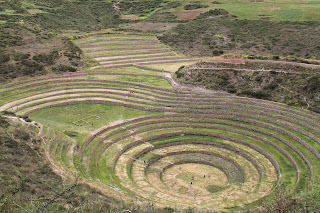With much anticipation, we embarked on our adventure to the heart and soul of the Incan Empire, and the pride of their construction abilities - towards Machu Picchu. On the way, we stopped at several towns and sights of other ruins.
This church on the edge of Chinchero, north of Cusco, was built on the foundations of an Incan settlement in the 1600s. It is very simple compared to many other colonial churches - no guilding or fancy tapestries or scultptures - very plain, but one of the most beautiful we've seen on the trip. The very simple colours, the mosaic ceiling, the rural location all made for a beautiful and peaceful setting.
Just outside the church, the misty morning made for a mystical Sacred Valley view.
This unique structure at Moray was an Incan farming laboratory where they experimented with different crops on different terraces and altitudes. It was quite large, and quite a uniqe place.
Just outside of Urubamba, a small spring flows from the side of a mountain. This spring is full of salts and minerals, and the Incas created the terraces below to farm the salt by creating hundreds of little waterways to fill the plots, and then divert the water elsewhere until the salt could be harvested before refilling the plots - incredible...
We reached Machu Picchu in the afternoon, andeven after all of the build up from everyone saying how incredible it is, we were struck by the magnitude of the place. The stone work, the terraces, the scenery - all just amazing. It was just incredible that they built this massive city on such a precarious perch, but the view explains all the hard work that went into it - just amazing.
Around the corner, about a 1km walk from the main structure is this Inca Bridge, which was part of the Inca Trail in the old days. Many beautiful flowers and views of the Urubamba River kept our attention as we meandered to this wooden bridge that was one of the few safeguards of the site.
Back at the main site, the Temple of the Sun - where most of the worship and sacrifices took place, was a unique structure where the priests ruled.







































